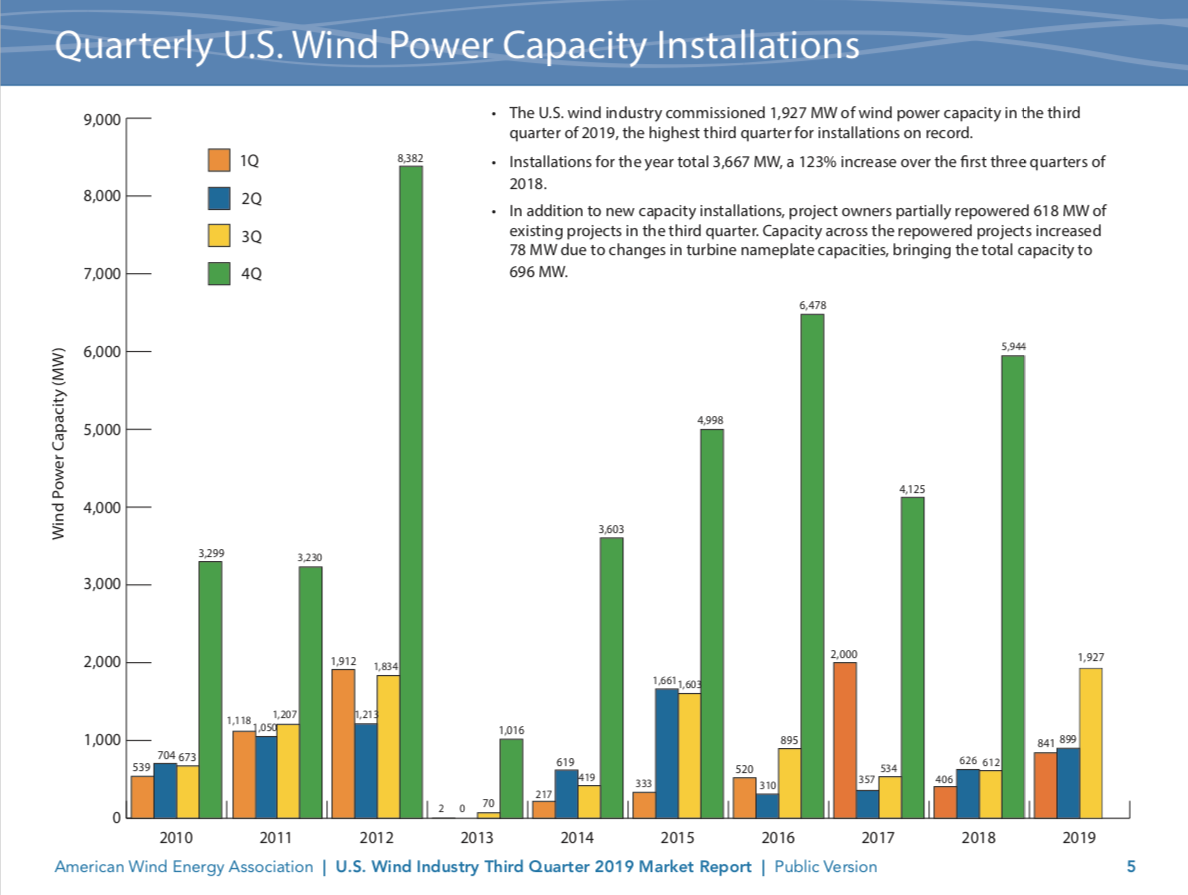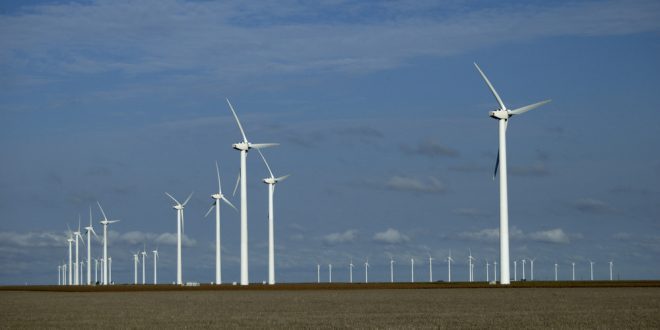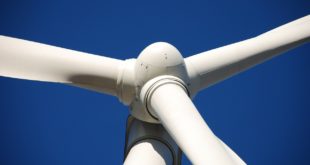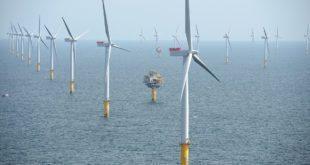Wind turbines near White Deer in Texas. Photograph: Shutterstock
By Michael Tobias
Wind power in the U.S. has more than tripled over the past 10 years making it the largest source of renewable power-generation capacity. Furthermore, it has effectively reduced carbon dioxide emissions by 151M metric tons since 2009, and in 2018 this reduction was equivalent to the emissions of 42.7 million cars.
This, in spite of the fact that nine states have zero installed power capacity.
But will we meet the Department of Energy’s goal to have wind power provide 10% of the country’s energy by 2020?
Growth of U.S. Wind Industry is Enormous
The stats mentioned above were shared by the American Wind Energy Association (AWEA) in its U.S. Wind Industry Quarterly Market Report for the third quarter of 2019.
According to the report, the major milestone reached by the U.S. wind industry at the end of the third quarter of 2019 saw new wind projects take the country’s total operating capacity to more than 100 gigawatts (GW) or 1,000 megawatts (MW).
Wind energy now provides more than 20% of the electricity produced in six states, and more than 32% in three states. During 2018, even before this milestone was reached, wind energy generated 6.5% of the electricity in the U.S. as a whole.
More than 57,700 wind turbines currently operate across 41 of the country’s states, as well as in two U.S. territories, Guam and Puerto Rico, producing a total 100,125 MW of operating wind energy.
Texas has maintained its lead in installed wind energy capacity, producing more than 27 GW in the third quarter, and proving to be the only state producing more than 10 GW!
Kansas became the fourth U.S. state to produce more than 6 GW of operating wind energy, with 6,128 MW. Iowa and Oklahoma have both exceeded the 8 GW level with 8,965 MW and 8,072 MW respectively, while California, originally a world leader, lags with an installed capacity of 5,842 MW.
One state, Illinois, now has more than 4 GW of installed capacity (4,887 MW), possibly inspired by Chicago engineers like our firm, that is keen to increase the capacity even further as quickly as possible.
Five states have more than 3 GW of wind capacity: Minnesota 3,845, Colorado 3,703, Oregon 3,222, North Dakota 3,155, and Washington 3,076. While two states produce more than 2 GW – Indiana 2,317 and Michigan 2,065, and six produce more than 1 GW – Nebraska 1,972, New York 1,987, New Mexico 1,953, Wyoming 1,536, Pennsylvania 1,369, and South Dakota 1,019 – the rest produce less than 1 GW.
Sadly, several U.S. states don’t figure in the equation at all, namely Alabama, Arkansas, Florida, Georgia, Kentucky, Louisiana, Mississippi, South Carolina, and Virginia. Hopefully this will change relatively soon.
New Wind Power Capacity Installations
AWEA analyzes new installations every quarter, and the third quarter of this year is the highest ever on record. Their statistics show that the wind industry commissioned 1,927 MW of wind capacity in the 2019 third quarter, with Texas leading capacity additions with 1,232 MW followed by Kansas (475 MW) and New Mexico (221 MW).
Installations for the year, so far, total 3,667 MW, which is 123% more than for the same period in 2018. It isn’t surprising that Texas leads with a total of 2,129 MW for the year, with Iowa (536 MW) and Kansas (475 MW) ahead of most states, but way behind Texas.
An encouraging factor is that since 2010, new capacity installations have been significantly greater in the fourth quarter, with 4,998 MW, 6,478 MW, 4,125 MW, and 5,944 MW recorded for the four years from 2015 to 2018. If this trend continues, the industry will creep closer to the Department of Energy’s 2013 Wind Vision goal of 10% of the energy end-use demand being served by wind by 2020. But there’s still a very long way to go before the 20% by 2030 and 35% by 2050 goals.
The question on many people’s lips is whether we will get close to the national 10% goal, and if so, how close?
Working Towards Wind Vision Goals
You could say it depends which way the wind blows, but there is a chance that we will meet the 10% goal by the end of 2020.
Think about it: in 2018 wind generated 6.5% of the electricity for the nation, with a total of 7,588 MW of wind power capacity – 406 for the first quarter, 626 for the second, 612 for the third, and 5,944 for the fourth. So far this year, the total wind power capacity amounts to 3,677. It more than doubled from 2018 in the first and third quarters, but what will the fourth quarter bring?
In 2016 the increase from third to fourth quarter was 895 vs 6,478 MW (an increase of more than 600%). In 2017 it was 534 vs 4,125 (an increase of more than 672%). Last year the third quarter figure was 612, soaring to 5,944 in the fourth quarter, which represents an increase of more than 870%.
If this trend continues, we could see a total increase in wind power capacity to as much as 14,000-19,000 MW.
And if 7,588 MW generated 6.5% last year, then even the lowest figure above could more than double the third quarter figure and take us to 10% before the end of 2020!
The AWEA chart from the “public” version of their report tells the story more vividly:

In addition to this, there are partially repowered projects that add even more capacity, as well as projects that are in advanced developed (on average underway for 14 months) or simply under construction for about a year. The AWEA report states there are advanced and under-construction projects that will deliver an additional 46,495 MW of wind power. These include 5,796 MW of offshore wind power.
Other Benefits of Wind Power
Energy efficient power is vitally important, but wind energy has other benefits too.
For instance:
- In 2018, the U.S. wind industry provided jobs to 114,000 people, with Texas leading the nation by employing almost a third of them (25,000).
- Wind projects pay more than $1 billion to both local and state governments as well as private landowners every year.
- The wind industry in the U.S. has invested more than $142 billion in new projects over the past 10 years.
- Private investors pumped $12 billion into wind projects in 2018 alone. Everybody benefits.
It’s exciting and it can only get better. I am sure that those offering engineering solutions in Chicago and other U.S. cities will play a pivotal role. I do hope so.
 Michael Tobias is the founder and principal of New York Engineers, an Inc 5000 Fastest Growing Company in America. He leads a team of more than 30 mechanical, electrical, plumbing, and fire protection engineers from the company headquarters in New York City, and has led numerous projects in New York, New Jersey, Chicago, Pennsylvania, Connecticut, Florida, Maryland, and California, as well as Singapore and Malaysia. He specializes in sustainable building technology and is a member of the U.S. Green Building Council.
Michael Tobias is the founder and principal of New York Engineers, an Inc 5000 Fastest Growing Company in America. He leads a team of more than 30 mechanical, electrical, plumbing, and fire protection engineers from the company headquarters in New York City, and has led numerous projects in New York, New Jersey, Chicago, Pennsylvania, Connecticut, Florida, Maryland, and California, as well as Singapore and Malaysia. He specializes in sustainable building technology and is a member of the U.S. Green Building Council.
 Alternative Energy HQ solar power for homes, wind energy, and bio fuel issues
Alternative Energy HQ solar power for homes, wind energy, and bio fuel issues








One comment
Pingback: Power of the Wind Grows Exponentially in the U.S.